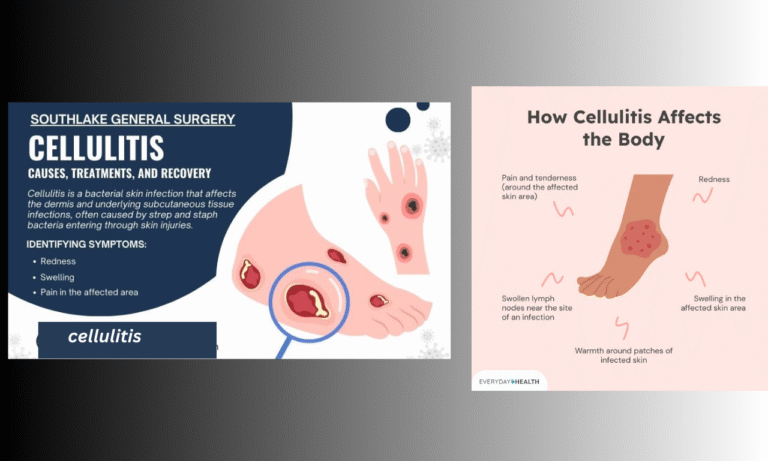I’ll never forget the first time I heard the word cellulitis. It wasn’t in a doctor’s office or on some medical TV show—it was actually when my friend texted me in a panic, saying her leg had turned red, swollen, and painful overnight. She thought it was just a bad insect bite, but when she went to the hospital, the doctor quickly diagnosed her with cellulitis.
That conversation stuck with me because, like most people, I had no idea how serious cellulitis could be. Fast forward a year later, and guess what? I found myself facing the same condition after a tiny scrape on my ankle got infected. Let me just say—it was painful, scary, and eye-opening. Today, I want to share my experience and some things I’ve learned along the way.
What Exactly Is Cellulitis?
Cellulitis is not your run-of-the-mill skin irritation. It’s a bacterial skin infection that usually shows up as red, swollen, and warm areas of skin. It can happen anywhere, but the legs are the most common spot.
In my case, it started with what looked like a harmless scrape from bumping into the corner of a coffee table. Within two days, the skin around it turned fiery red, felt warm to the touch, and the swelling made it hard to walk. That’s when I knew this wasn’t something I could just “wait out.”
The Symptoms I Noticed
Everyone experiences cellulitis a little differently, but here’s what I personally went through:
-
Redness spreading quickly around the cut
-
Warmth and tenderness in the infected area
-
Swelling that made my shoe feel tight
-
A dull ache that turned into sharp pain when I moved
-
A slight fever (which was the big red flag for me)
If you ever see redness spreading or feel a fever along with skin irritation, that’s your cue to get medical attention. Cellulitis isn’t something to ignore—it can spread fast and lead to serious complications.
What Causes Cellulitis?
Most often, cellulitis is caused by bacteria like Streptococcus or Staphylococcus. These germs sneak in through:
-
Cuts or scrapes
-
Insect bites
-
Cracked, dry skin
-
Surgical wounds
-
Athlete’s foot (a sneaky one I learned about later)
For me, it was literally a tiny scrape I barely noticed. I cleaned it with water but didn’t cover it with a bandage. Lesson learned: don’t underestimate small wounds.
How Cellulitis Is Treated
When I went to the doctor, they didn’t waste time. I was prescribed antibiotics right away. Within 48 hours, the swelling started to ease up, but it still took a good week before my skin looked normal again.
Here’s the standard treatment plan most people follow:
-
Antibiotics (oral for mild cases, IV for severe ones).
-
Pain relievers like acetaminophen or ibuprofen.
-
Rest and elevation of the affected area.
-
Hydration and skin care to support healing.
I’ll be honest—the first two days on antibiotics didn’t feel much better, and that was frustrating. But once they kicked in, the relief was huge.
My Personal Tips for Managing Cellulitis
I learned a lot from this experience, so here are two things I’d pass along if you ever face something similar:
1. Don’t Wait Too Long to Seek Help
I almost brushed it off, thinking it would heal on its own. That’s probably the biggest mistake people make. If you see redness spreading, don’t delay. Early treatment makes recovery much easier.
2. Keep a “Wound Care Kit” at Home
Now, I always keep antiseptic wipes, clean bandages, and antibiotic ointment in a small kit at home. Anytime I get a cut or scrape, I clean it right away and cover it. It’s a small step that can save you from big trouble later.
Preventing Cellulitis in the Future
After my little scare, I started paying closer attention to my skin health. Here are some practical ways to prevent cellulitis:
-
Keep skin moisturized to avoid cracks.
-
Treat athlete’s foot or fungal infections quickly.
-
Trim nails carefully to avoid accidental scratches.
-
Wear protective clothing when gardening or hiking.
-
Clean and cover wounds immediately, no matter how small.
Honestly, prevention is much easier than going through the pain and stress of cellulitis treatment.
When to See a Doctor Immediately
From my personal perspective, you should never ignore these signs:
-
Rapidly spreading redness
-
Fever, chills, or sweats
-
Blisters or pus-filled bumps
-
Severe pain or swelling
-
Numbness or tingling around the infected area
If you notice any of these, skip the home remedies and go straight to a doctor. I know it can feel like overreacting, but trust me—it’s better to be safe than sorry.
Related Conditions to Be Aware Of
I didn’t realize this before, but cellulitis can sometimes be mistaken for other issues like:
-
Deep vein thrombosis (DVT)
-
Eczema flare-ups
-
Contact dermatitis
-
Shingles
That’s why a professional diagnosis is so important. Even if you think it’s “just a rash,” it may be something more.
Living with the Fear of Recurrence
One thing I’ll admit is that after having cellulitis once, I became more cautious. Anytime I see a bug bite swell up, I watch it like a hawk. While cellulitis can come back, staying proactive with wound care has given me peace of mind.
Final Thoughts on Cellulitis
Cellulitis might sound like a complicated medical term, but it’s something anyone can experience. I learned firsthand how quickly it can develop and how important it is to take skin health seriously.
If you take away one thing from my story, let it be this: don’t ignore redness, swelling, or pain on your skin—especially if it spreads quickly. A short visit to the doctor can save you a lot of pain and potential complications.

